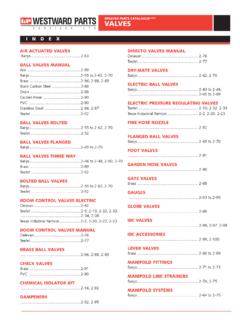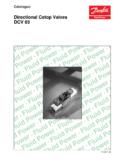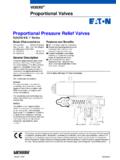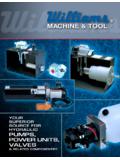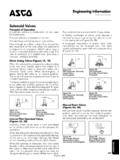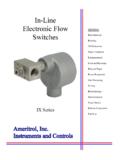Transcription of TROUBLE SHOOTING GUIDE - HardiSprayer.Com,
1 TROUBLE SHOOTING GUIDE DIAPHRAGM PUMP PROBLEM SOLUTION Loss of Operating Pressure 1 Plugged suction filter 2 Air leak on suction side a. Defective o-ring b. Pin hole in hose c. Crack in plastic fitting 3 Plugged or partially plugged suction tube (inside tank) 4 Self-cleaning filter cone contains fluid 5 Self-cleaning filter screen plugged 6 Self-cleaning filter cone stuck 7 Defective constant pressure seats 8 Defective o-ring in Hardi-matic valve 9 Excessive return fluid causing turbulence around suction tube 10 Agitaion nozzle (inside tank)
2 Fallen off 11 Foreign material lodged in pop-off valve 12 Defective gauge 13 In-line filters plugged 14 Low fluid level in tank 15 Foreign material lodged in pop-off valve 16 Defective pump valves Pump is slow to prime 1 Air leak on suction side 2 Suction filter plugged 3 Agitation bypass valve in wrong postion 4 Suction tube jammed into sump (Nav 1000) 5 Suction tube plugged 6 Defective o-ring in Hardi-matic valve 7 Foreign material lodged in pop-off valve 8 Foreign material lodged in pump valves 9 Defective pump valves Fluid leaking from bottom1 Diaphragms defective of pump2 Hairline crack in main pump housing or front cover Fluid leaking around diaphragm1 Cover retaining bolts loose covers2 Valve o-rings defective3 Pinched diaphragm4 Diaphragm cover cracked Excessive jumping of suction 1 Restricted or plugged suction filter hose (spiral renforced ) 2 Air leak on suction side a.
3 O-ring at suction filter b. Pin hole in suction hose c. O-ring at main / flush tank valve d. O-ring at suction fitting on pump e. O-ring at fittings on pressure regulator (NP 1100) f. O-ring at pop off valve (NP 1100) g. O-ring at S-93 tee, suction hose to pump (NP 1100)13 Suction valve, main tank/flush tank valve, closed4 Suction tube (inside tank) plugged5 Suction tube (inside tank) touching bottom of sump (Navigator 1000 and 1000 M) Excessive jumping of pressure 1 Self-cleaning filter cone contains fluid hose (smooth hose)2 Self-cleaning filter screen plugged 3 Self-cleaning filter cone stuck 4 Agitation bypass valve in wrong position 5 Foreign material logged in pump valves 6 Defective pump valves Sudden Pressure Fluctuation1 Suction filter beginning to plug +/- 10 to 15 psi.
4 2 Self-cleaning filter cone sticking 3 Restriction in bottom of self-cleaning filter 4 Self-cleaning filter screen plugging5 Fluid in self-cleaning filter cone 6 In-line or tip screen filters plugging7 O-ring in Hardi-matic valve blown8 Agitation nozzle (inside tank) loose 9 Pump cavitation (low fluid level) Loss of pressure while spraying 1 Suction filter beginning to plug 2 Pin hole in suction hose 3 In-line or tip screen filters plugging 4 Pin hole in suction tube 5 Excessive return fluid around bottom of suction tube6 Foreign material lodging in pump valves Excessive pressure variation1 Constant pressure seats worn between manifold and boom2 Fluid in self-cleaning filter cone gauges 3 Self-cleaning filter screen plugging 4 Cone sticking in bottom of housing
5 5 Defective gauge 6 Chemical buildup in boom tubes 7 Restriction in bottom of self-cleaning filter Ball valve turns hard 1 Ball and ball seat dry due to chemical 2 Ball or ball seat damaged 3 Displaced o-ring restricting ball Pressure fluxuation when boom1 Constant pressure not properly set valve turned off 2 Constant pressure seats worn 3 Constant pressure seats defective Loss of pressure after refill 1 Suction tube touching bottom of sump restricting pump flow (Navigator 1000) 2 Suction filter plugging 3 Agitation bypass valve set to pump (if so equipped) 4 Suction valve closed 5 Agitation nozzle (inside tank)
6 Fallen off6 Chemical filler valve open7 Foreign material lodged in pump valves Hose blows or valve seperates 1 Pop-off valve stuck or set too higjh from excess pressure2 Pressure side valve closed 3 Fluid in self-cleaning filter cone 4 Screen in self-cleaning filter plugged25 Self-cleaning filter cone stuck Poor agitation 1 Agitation valve closed 2 Agitation line or nozzles restricted 3 Air leak on suction side4 Low pump pressure Can't get all the fluid out 1 Sprayer not leveled of the tank 2 Suction tube cut too short 3 Excessive fluid return around sump 4 Pin hole or crack in lower part of suction tube NOTE; In some application where low gallons per acre is desired, unused fluids returning to the tank may cause a vortex to develop around sump causing cavitation of pump resulting in lost pressure and an inabilty to draw fluid from the tank when tank levels are low.
7 CENTRIFUGAL PUMPS It is very important to remember that operating a Centrifugal Pump without fluid present will cause internal seal damage and necessitate seal replacement. Pump does not pime 1 Pump is air locked 2 Shut off valve (under tank) closed 3 Flush tank? Main tank valve closed 4 PTO pump drive belt slipping 5 Damaged impeller 6 Outlet port in bottom of tank plugged or restricted 7 Hydraulic drive pump damaged 8 Drive gears defective (Hypro Pump) BOOM PRESSURE AND SECTION CONTROL VALVES Manual valves are used on smaller units and the most common model of valves used are the M-70 and BK-180 The majority of field sprayers use Electric control valves.
8 While models of of controls vary, some components are the same regardless of the model. boom control valves and pressure regulating valves are all the same. Pressure motor only turn 1 Switch in control box not making good contact one way2 Defective pressure adjust switch in control box 3 Defective micro-switch in pressure motor housing 4 Poor connection between boom control box and main control cable 5 Poor connection inside boom control box 6 Poor connection at circuit board inside junction box (located below boom valves 7 Defective circuit board in boom control box)
9 8 Defective circuit board in junction box9 Defective pressure motor Fluid leaks between boom1 Stainless steel nut on end of valve assembly control valves loose 2 Defective o-rings between valve bodies 3 Cracked valve housing3 One boom valve not working 1 Boom switch not making good contact 2 Defective boom control box switch 3 Poor connection in boom control box 4 Poor connection between boom control box and main cable 5 Poor connection on circuit board in junction box (located below boom valves)
10 6 Defective circuit board in control box 7 Defective circuit board in junction box 8 Pinched wire in main cable9 Defective boom motor Fuse in control box blows1 Defective fuse holder continuously 2 Wrong AMP fuse 3 Defective switch 4 Defective roller in boom control valve 5 Pinched wire in main cable 6 Defective boom or pressure motor 7 Defective circuit board in control box 8 Defective circuit in junction box Unable to balance boom 1 Constan pressure seats worn Boom sections not spraying1 In-line filters or tip screens plugging equal amounts 2 Worn nozzles 3 Worn rollers in boom valves 4 Constant pressure seats worn 5 Chemical buildup in nozzles tubes 6 Kink or partial plug in boom feed hoses Boom control box does not work 1 Blown fuse 2 Power supply cable damaged 3 Loose or broken wire in male plug for

